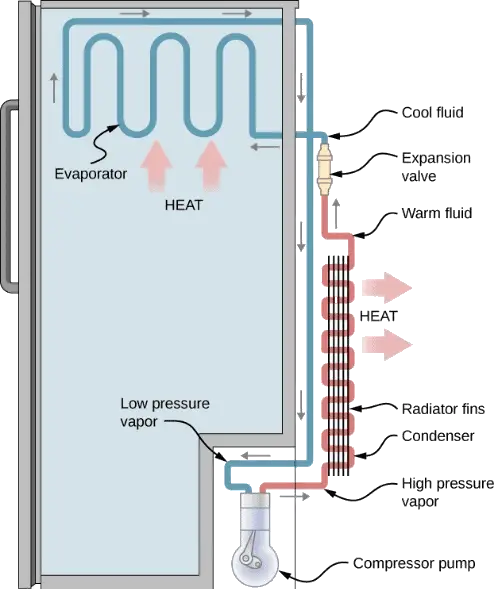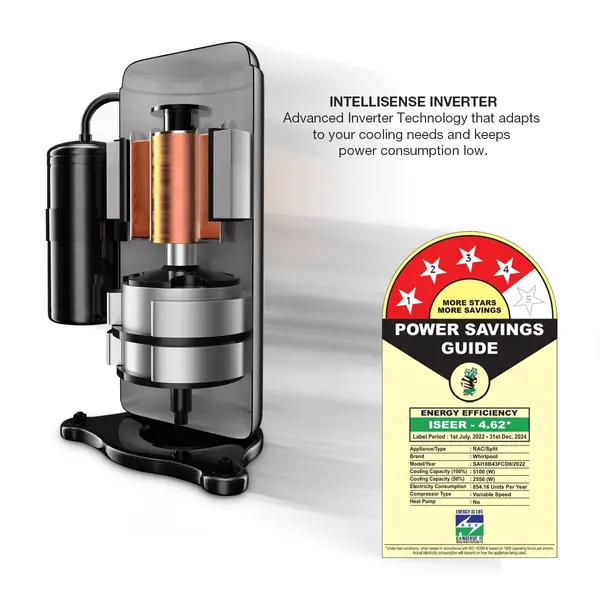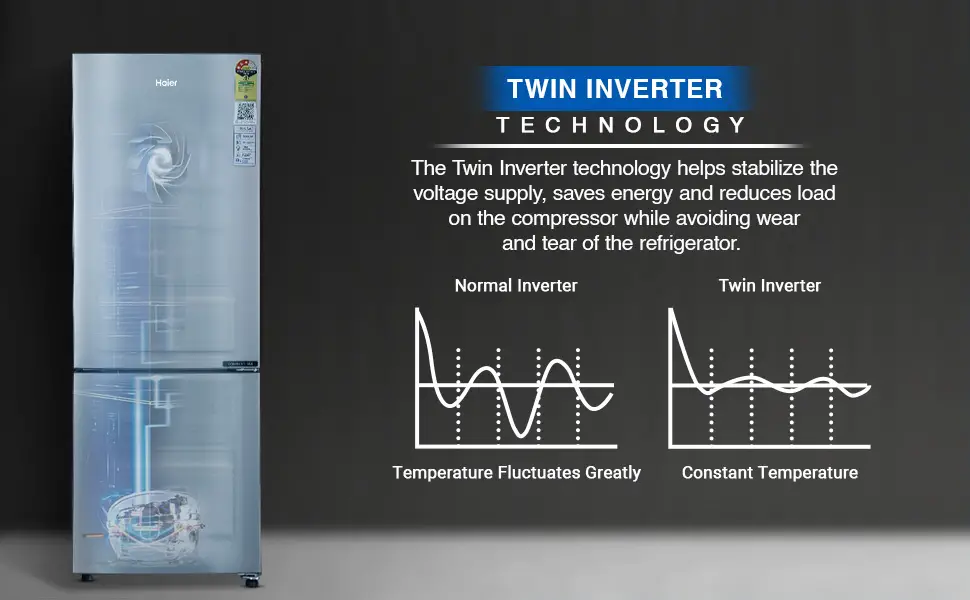First, an Inverter Refrigerator has nothing to do with a power inverter. This means the inverter refrigerator is not meant to run during a power cut.
Then what does an Inverter Refrigerator do? Why is there so much hype about the inverter technology in refrigerators? Let’s learn about that here in this article.
Before we learn about Inverter Refrigerators, we should learn a bit about how a refrigerator works.
How Does A Refrigerator Work?
A typical refrigerator has four processes. All processes are cyclic, which means they will continue until you manually stop them.
The main element of a refrigerator is the Refrigerant. In its ideal state, refrigerant is a liquid that flows around different parts of the refrigerator and removes heat from the food.
Here are those four processes of a typical refrigeration cycle.

Evaporation
The evaporator has pipes through which liquid refrigerant passes. You can not see the evaporator until you remove the plastic cover on top of it.
When refrigerant comes to the evaporator, it will be liquid and under low pressure. While flowing through the evaporator, the refrigerant absorbs all heat from the food and converts itself into a gaseous state. The pressure remains low while the refrigerant leaves the evaporator.
Compression
After the evaporator, the refrigerant gas enters the compressor, where a motor compresses it to increase its temperature and pressure.
A compressor is the heart of a refrigerator. You might see a black oval-shaped part at your refrigerator’s back ( bottom side). Right? That is the compressor.
Condensation
Did you notice those black pipes at the back of your refrigerator? They are condenser pipes, and they are either made of copper or aluminum.
After the compressor, the high-pressure and high-temperature refrigerant enters the condenser. While passing through the condenser, the refrigerant gas dissipates all the heat absorbed while in the evaporator.
Due to the heat dissipation, the refrigerant again goes back to the liquid state
Expansion
All refrigerators have expansion valves that reduce the pressure of the liquid refrigerant from the condenser. The refrigerant is liquid and low-pressure when it exits the expansion valve.
After the expansion valve, the refrigerant again enters the evaporator, and the cycle continues.
Once the refrigerator compartment is sufficiently cooled, a thermostat detects the temperature and automatically stops the refrigerant flow. When the temperature rises again, the refrigerant starts flowing again.
As you can see, the compressor plays a big role in the refrigeration cycle. Refrigerators have two types of compressors: a single-speed standard compressor and a variable-speed inverter compressor.
How Does A Standard Compressor Work?
A standard compressor is a single-speed compressor. It will either run at full speed or shut down. A standard refrigerator runs at around 3600 rpm at full load.
When the refrigerator’s desired temperature is reached, the thermostat cuts off the refrigerant flow, and the compressor turns off.
Then again, the compressor turns on when the temperature shoots up and starts the process.
Due to this frequent shutdown and start-up, standard compressors consume a lot of energy. They also generate a lot of heat and sound, which tends to damage the internal parts. The result is that the parts will wear and tear much faster than other types of compressors.
Think of a mobile battery that consumes 5-10% of power when you switch on the mobile. In the same way, a compressor also consumes a lot of power when it starts.
What Is An Inverter Compressor Or Inverter Refrigerator
An Inverter compressor never shuts down. It optimizes the motor speed based on the cooling load.
When the desired temperature is reached, the compressor speed decreases, and then when more cooling is required, the speed increases again.
Let’s take the example of a car accelerator that consumes more fuel when you press the accelerator pedal to get more power.
Similarly, when you need more cooling, inverter compressors will do more work and thus consume more power.
But when cooling is not required, it reduces the motor speed to save power.
As compressors do not frequently shut down or start up, inverter refrigerators can, on average, save up to 40% of your power bill.

Different Types Of Inverter Compressors
Although the core technology is the same, different manufacturers have given this technology different names after adding their customized features. Here are some of the different types of Inverter Compressors.
Samsung Digital Inverter Compressor
Samsung named it Digital Inverter Compressor because a microprocessor controls the compressor. It has 7 different speed levels that optimize the motor speed based on the cooling load.
It has 9 different types of sensors that give inputs to the microprocessor, such as cooling load, internal and external temperature, and humidity level.
LG Smart Inverter / Inverter Linear Compressor
LG uses smart inverters in low-cost models, whereas the inverter linear compressors are used in premium refrigerators.
LG’s smart inverter technology is the same as Samsung’s Digital Inverter technology. Both use microprocessors to optimize the speed of the motor based on the input it receives from different sensors.
LG Inverter Linear Technology is used in premium models. It is basically a special compressor with electromagnets that reduces the frictional points to 2 from 4.
Less friction means less power consumption, noise, and wear and tear.
Whirlpool IntelliSense Inverter / Plasma Inverter
The IntelliSense Inverter’s working principle is the same as that offered by LG and Samsung, although Whirlpool uses only 3 sensors.
One sensor detects the outside temperature, one checks the cooling load, and the remaining one checks the usage pattern to optimize the motor speed.

Plasma Inverters use an additional coating on the compressor rod to prolong the part’s life. This is in addition to all the features that the IntelliSense inverter gets.
Due to the plasma coating, there is less friction, which results in more power savings. Plasma coating enhances the life of a compressor by up to 5 years compared to a traditional inverter compressor.
Godrej NutriFresh Inverter
Godrej Nutrifresh Inverter technology is similar to other Inverter technologies already discussed in this article. However, it can optimize the cooling based on not only the cooling load but also the type of food. That is why this technology is called Nutrifresh Inverter technology.
The unique Nutrifresh Inverter Compressor technology ensures that food stays for up to 6 days.
Haier Twin Inverter Technology
The main benefit of Twin Inverter Technology is that it can maintain a constant temperature output. So you will always get balanced cooling.
It also helps stabilize the voltage supply, reduces the load on the compressor, and thus saves power.
Twin Inverter Technology can provide more stable working conditions when the input voltage is unstable.

Benefits Of Inverter Refrigerators
Here are some of the benefits of having an Inverter Refrigerator.
- The inverter compressor does not shut down and start as frequently as a traditional compressor. Thus, it produces less noise.
- Less wear and tear of internal parts.
- Up to 40% power saving due to the use of a variable speed BLDC motor
- Balanced cooling, as the compressor does not shut down at all
- Inverter Refrigerators often come with many other modern technologies, which is a plus
Any Drawbacks of Inverter Refrigerators?
The only drawback I can think of is the servicing of inverter refrigerators. Since there is a microprocessor and a bunch of sensors, if anything goes wrong, you need to spend a hefty amount to repair it. You may also need to call a skilled technician to repair it.
The other issue with the Inverter Refrigerator is its price. Inverter Refrigerators cost at least a 20% premium over normal refrigerators, although that amount can be easily compensated by saving on the monthly power bill.
Conclusion: Shall I Buy An Inverter Refrigerator?
Of course, inverter refrigerators are the future. Not only can it save power for you, but it also produces less noise, less wear and tear, and most importantly, it increases the refrigerator’s life.
Though Inverter Refrigerators are indeed costly, the price difference between them and non-inverter refrigerators is not that great. That extra money can be easily recovered within one year of usage.